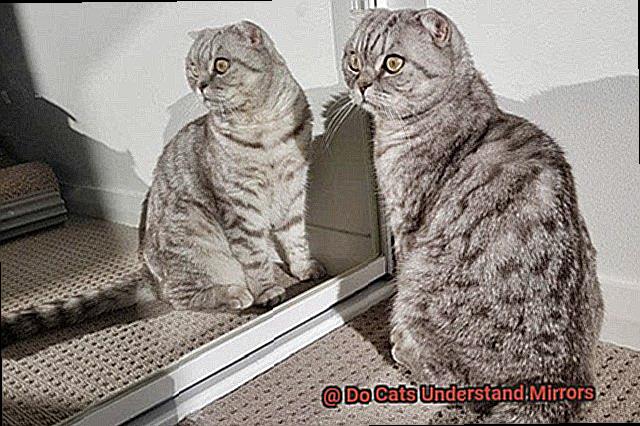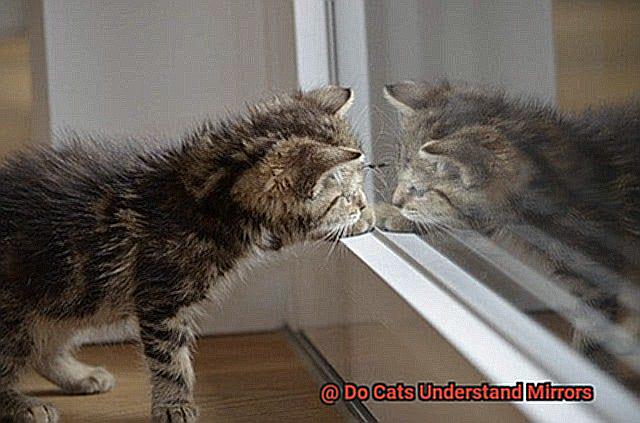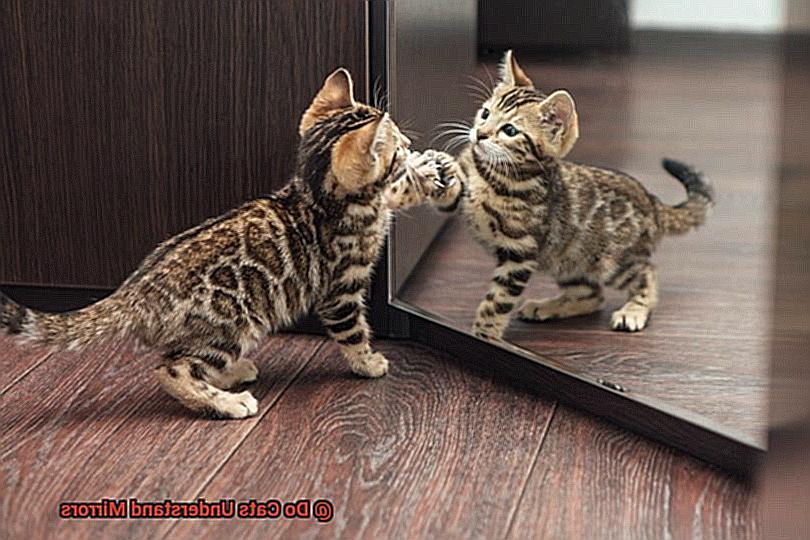Do cats understand mirrors? It’s a question that has been debated for centuries and continues to fascinate cat owners. Although it’s impossible to answer this fully, evidence suggests cats do have an understanding of their reflections.
Have you ever seen your cat pause and gaze at its reflection in a mirror? Many cats will do this, as if trying to make sense of what they are seeing.
This could be because they don’t recognize themselves or because they believe the image is another animal intruding on their territory. In experiments, two cats were placed side by side with a mirror between them.
Both cats responded more vehemently after seeing the reflection of another cat than when they only saw their own reflection. This indicates that cats can tell the difference between themselves and other felines when looking into a mirror.
So, although we may never know for sure, it appears cats can comprehend the concept of mirrored images.

Self-Awareness: How Cats Recognize Themselves in Mirrors
The answer is a resounding yes.
Cats possess a certain degree of self-awareness that allows them to recognize their reflection as themselves. However, this doesn’t mean they understand what a mirror is or how it works.

When cats first encounter a mirror, their reaction can vary greatly depending on their personality and experiences. Some cats may be enthralled by the sight of their reflection, while others may be indifferent or even scared.
If the cat sees its reflection as a threat, it can often lead to confusion or aggression. Cats usually develop enough cognitive skills to tell the difference between their reflection and that of another species at around 24 to 26 months old.
It’s important for pet owners to observe their cat’s behavior around mirrors and take appropriate action if necessary.
Cat Reactions to Mirrors: Fascination, Indifference, or Fear

It turns out that cats have a range of responses when it comes to mirrors, from fascination to indifference or even fear.
Younger cats often display playful behaviors such as pawing or jumping towards the image, vocalizing or purring when they see their reflection in a mirror. This is because they may not yet fully understand the concept of reflection.
On the other hand, older cats may glance briefly at the mirror before turning away or simply ignore it completely as they’ve already learned through experience that the image is not real. However, some cats can show fear or aggression when encountering a mirror.
This reaction may be due to feeling threatened by the unfamiliar image or simply not understanding what they are seeing. It’s important to note that these reactions are not indicative of intelligence or cognitive abilities; some cats may just not be interested in this form of visual stimulation.
If you observe your cat’s behavior around mirrors, it’s best to watch them closely and take prompt action based on their reactions.
Understanding Mirrors: Do Cats Grasp What They’re Seeing?
This age-old question has long puzzled cat owners.
While cats may not comprehend mirrors in the same way as humans, they can still recognize themselves in them and even find them amusing or confusing. Cats rely more on their sense of smell and hearing than sight when it comes to understanding mirrors.
This means that some cats may try to paw or play with their reflection as if it were another animal, while others may simply ignore it altogether. It’s also important to note that when confronted with a mirror, cats may become distressed or frightened, particularly if they are not familiar with them or have had bad experiences in the past.
If your cat is scared or confused by their reflection, provide them with comfort and reassurance until they feel more comfortable in the situation.
Confusion and Aggression: The Risk of a Cat Perceiving its Reflection as a Threat
Mirrors can cause confusion and even aggression in cats.
When a cat sees its own reflection, it may not understand what it is seeing and perceive the image as a potential threat. This can lead to hissing, growling, or even attacking the mirror which can cause injury or damage to both the cat and the mirror.
It is important for pet owners to be aware of their cats’ reactions to mirrors and intervene if necessary. If a cat is exhibiting signs of fear or aggression towards its reflection, it is best to remove or cover up the mirror.
Distracting the cat with toys or interactive activities can also help redirect its attention away from the mirror. Prolonged exposure to mirrors can lead to stress and anxiety in cats, so it is essential that their environment is safe and secure.
Supervising Interaction with Mirrors: Ensuring Your Cat’s Safety and Wellbeing

Cats and mirrors can be a curious combination, as many owners wonder if their furry friends understand their own reflection.
While cats do recognize themselves in mirrors, they may not handle them as well as humans. It’s essential to supervise your cat’s interaction with mirrors, as this can be a potential source of danger.
Cats may become territorial towards their reflection if they perceive it as a threat, leading to injury or anxiety. To ensure your cat’s safety and wellbeing, introduce them to a small mirror from a young age and encourage them to explore it slowly.
Every cat is unique and will respond differently when faced with a mirror. Some may be fascinated by their own reflection, while others might be indifferent or even scared of it.
As an owner, it’s important to understand your cat’s behavior and make necessary adjustments for their safety. Mirrors can be an exciting part of your cat’s life, but they must always be monitored and controlled.
You can help ensure that your cat has a positive experience by understanding their needs and being aware of any signs of distress or aggression.
Tips for Creating an Environment That Is Safe for Your Cat
As pet owners, we have the responsibility to ensure that our cats live in a safe and comfortable environment. Whether you’re a new cat parent or an experienced one, here are some tips for creating a secure home for your feline friend.
Provide Enough Space

Cats need plenty of space to roam around and explore, so make sure there are designated areas in your house where they can scratch, climb, and play. This includes investing in scratching posts, cat trees, and comfy cat beds that are placed in different parts of the home.
Keep Dangerous Items Out of Reach
As curious creatures, cats can easily get into things they shouldn’t. Be sure to keep any hazardous items such as toxic plants, cleaning supplies, small objects that they could swallow, and electrical cords out of their reach.
Maintain Cleanliness
Cats are very particular about their environment so it’s important to keep it clean and tidy at all times. Make sure to regularly clean out the litter box as well as their food and water dishes.
Secure Open Windows and Balconies
If you have open windows or balconies in your house, be sure to secure them with screens or other barriers so your cat does not accidentally fall or escape.
Provide Mental Stimulation and Playtime
To be happy and healthy, cats need plenty of mental stimulation as well as playtime. This includes playing with interactive toys such as feather wands or laser pointers, setting up perches near windows where they can watch birds and other wildlife outdoors, and providing puzzle feeders that will keep them entertained for hours on end.
Also Read: Why Does My Cat Scratch the Mirror? – 21Cats.org
Conclusion
Do cats understand mirrors? It’s hard to say for sure, but it appears that they can recognize their own reflection. While some cats may be fascinated by the mirror, others may be fearful or aggressive.
As long exposure to mirrors can lead to stress and anxiety, pet owners should pay attention to their cat’s behavior around mirrors and take prompt action if needed. To ensure a positive experience with mirrors, start slowly from a young age and provide plenty of mental stimulation and playtime.
Moreover, create a safe environment for your cat – keep hazardous items out of reach, maintain sanitation in the house, and ensure ample space for them to explore.







